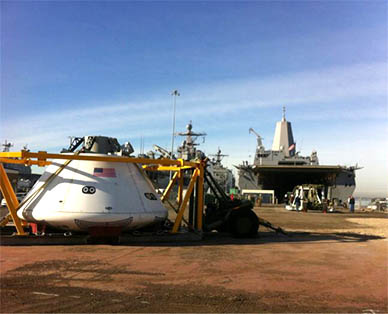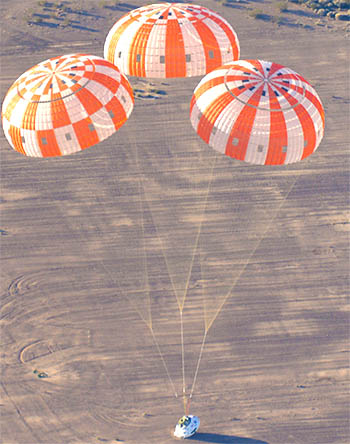Orion Spacecraft Underway Recovery Testing Begins
By Space Coast Daily // February 19, 2014
recovery test will continue through Feb. 21
ABOVE VIDEO: The first test to ensure Orion will successfully jettison its Forward Bay Cover (FBC) was conducted by Lockheed Martin on Dec. 19. The FBC protects the top portion of the crew module during launch, orbital flight, and re-entry. When Orion reenters the Earth’s atmosphere from deep space, the FBC will be jettisoned at an altitude of approximately 23,000 feet.
NASA.gov — About a hundred miles off the coast of San Diego, in the Pacific Ocean, a U.S. Navy ship’s well deck filled with water as underway recovery operations began Feb. 18 on a test version of NASA’s Orion crew module to prepare for its first mission, Exploration Flight Test-1, in September.
Orion was undocked from its cradle and allowed to float out to sea.

Building on the knowledge gained from previous Orion recovery tests performed in calm waters near NASA’s Langley Research Center in Virginia, the agency’s Ground Systems Development and Operations (GSDO) Program began the next phase, seeking turbulent water off the west coast in which to practice recovering the Orion crew module, one parachute and a forward bay cover, which keeps Orion’s parachutes safe until being jettisoned, just before the parachutes are needed.

“This is an end-to-end test that takes us to the edge of our safe zone,” said Mike Generale, the Orion recovery operations manager and test director at NASA’s Kennedy Space Center in Florida.
“It will help us see how successful our processes and hardware are to recover Orion in higher sea swells.”
During the recovery test, controllers at Johnson Space Center in Houston simulated the launch and splash down of the Orion capsule.
An F-18 jet flew from 13,000 feet into a dive to simulate Orion’s descent through the atmosphere and splashdown, as Johnson confirmed tracking and cleared the air space. Helicopters were stationed in the air to observe the “Orion capsule” during descent, as they would be during an actual retrieval mission.
The ship circled around to the floating test vehicle, and an integrated team of U.S. Navy amphibious specialists, engineers and technicians from Kennedy, Johnson and Lockheed Martin Space Operations practiced retrieving Orion, the forward bay cover and parachute.
RECOVERY TEST WILL CONTINUE THROUGH FEB. 21
A sea anchor and recovery winch was attached to Orion. The recovery winch attachments were secured between Orion’s two main windows, near the heat shield.

For the underway recovery test, even though there are no propellants or coolant on the capsule, the small boat teams examined Orion for leaks, just as they will following Exploration Flight Test-1.
Then, two rigid-hull inflatable boats and two smaller Zodiac boats were used to help guide Orion into the Navy ship’s flooded well deck and secure it in a specially designed cradle. Water was drained from the well deck, leaving Orion secure and dry.
Two more rigid-hull inflatable boats were used to secure and reposition the recovered forward bay cover and parachute to the port side of the Navy ship where a crane lifted them on the ship’s main deck.
Generale said the underway recovery test allows GSDO to verify recovery operations and procedures, demonstrates capabilities and incorporates partnership efforts with the U.S. Navy and Lockheed Martin.
“The next steps will be to incorporate lessons learned and, if needed, modify Orion recovery hardware,” Generale said.
The underway recovery test will continue through Feb. 21.












